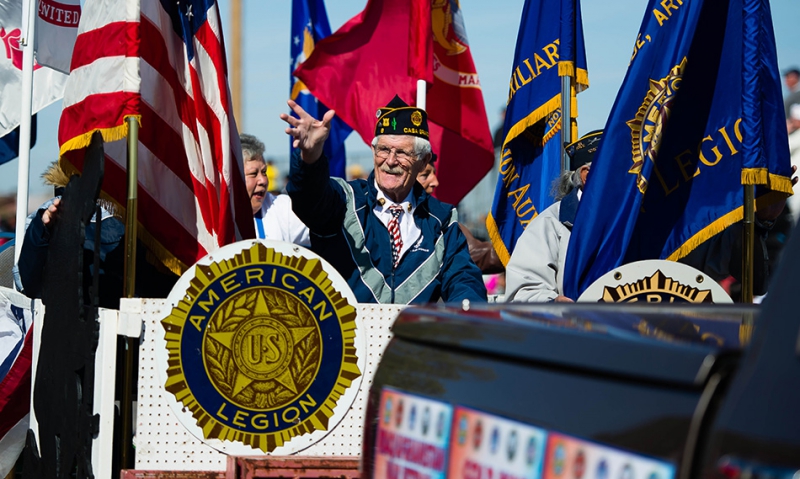
Department of Arizona Post 84 Legionnaires have seen the annual event, which started in 1984, grow from a few onlookers to more than 2,000 attendees.
The American Legion Department of Arizona Post 84’s first commemoration of the Iwo Jima flag-raising featured six Legionnaires marching. They waved to dogs, rabbits and the few onlookers.
“I didn’t care if there were only 20 people waving at us, we were going to march,” recalled Oscar Urrea, Post 84 member and the coordinator of the annual event that began in 1984.
The commemoration has evolved rapidly from its early roots. On Saturday, Feb. 22, the event kicked off with flyovers by a B-17 Flying Fortress and six Stearman biplanes, then transitioned to a parade featuring 120 groups, including American Legion posts from at least four states. In all, participants representing 20 states and 22 different Native American tribes played a role.
The largest applause from the crowd – at 2,000-plus strong – was reserved for approximately 15 World War II veterans, including Navajo Code Talker George B. Willie Sr., USS Indianapolis survivor Adolfo Ceyela, and Legionnaires Oliver Babbitts and Dennis Kavanaugh, who were on Iwo Jima on Feb. 23, 1945, when six Americans triumphantly raised the U.S. flag.
Ira H. Hayes was among those six Americans, a point of pride for the Gila River Indian Community in Sacaton, where a memorial park – organized and designed by Urrea – honors the young Marine born and raised on the reservation.
Urrea is driven to keep the story alive with the annual event and the park: “Ira Hayes was born in this community. Let’s make him proud.”
Kavanaugh, a Marine like Hayes, didn’t actually see the flag being raised but quickly recognized what was happening.
“I heard bells on the ships off the coast, then a general roar,” said Kavanaugh. “I was so surprised because all of a sudden there was cheering. We turned around and looked and saw the flag on the hill. You talk about a thrill. I was really glad to see that. My god, they made it. … I still get emotional thinking about that flag.”
Of course, when the Americans raised the flag on Mount Sirabachi, they also removed the Japanese one. That flag – bearing the Americans signatures, including Hayes’ in the middle of the red sun – now belongs to Post 84. It was given to the post by Cpl. Don Mortensen and is only taken out of storage for the commemoration event.
While the image of the U.S. flag being raised unifies the broad range of participants, the commemoration is more than that. It’s a celebration of America’s perseverance during WWII, Native American culture and the Marine brotherhood.
“We’re part of a group that’s special, unique,” Kavanaugh said. “Combat Marines have a bond that is beyond explanation. We know that we are helping each other out. Once a Marine, always a Marine. This is why we keep coming back because of this bond and this commemoration. It brings back some fond memories of the men we knew and those that didn’t make it.”
Gregory Mendoza, governor of the Gila River Indian Community, pointed out what the Iwo Jima image portrays.
“We are commemorating and remembering a brief moment during an armed conflict,” Mendoza said. “We are fortunate that it was caught within the lens of a camera and has become a symbolic and significant representation of the valor of our servicemen and servicewomen.
“However, in the midst of our remembrance let us not forget that other similar moments demonstrating bravery, honor and sacrifice did not find themselves similarly captured or portrayed, and therefore honored and remembered. It is these moments as well that we all need to be very mindful of and remember during our moments of appreciation.”
Urrea is determined to keep driving that message home.
“I want others to know about freedom,” he said, pointing to the word emblazoned on the stage at the center of the memorial park. “We can’t forget that. That’s what sums it up: The freedom of this nation. It was the sacrifice that was given by those that survived. And we honor those that did not survive.”
Next year, will mark 70 years since the flag-raising. Urrea is already planning for the special anniversary.
“Seventy years will be a big one,” he said. “We’re definitely going to make it special. My goal is to get all 81 Native American nations represented. We’ll have a big event – and make Ira proud.”
- Honor & Remembrance

